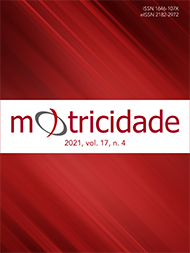Effects of isostretching on quality of life and functional capacity in women with low back pain in a health unit
DOI:
https://doi.org/10.6063/motricidade.20624Keywords:
low back pain, public health, quality of life, Physical Therapy ModalitiesAbstract
The aim was to evaluate the effects of isostretching on quality of life, functional capacity and pain in adult women with chronic low back pain in a health unit. It was a non-randomized controlled clinical trial. The groups were divided into Intervention Group (IG, n= 14) and Control Group (CG, n= 10). The participants were assessed before and after the intervention through the SF-36 Life Quality Questionnaire, Owestry Incapacity Index (ODI) and Visual Analogical Pain Scale (VAS). The interventions occurred through 3 months, 2 times per week, with a duration of 60 minutes each, totalizing 24 sessions. In the intragroup comparison, there was observed in all SF-36 domains and VAS in GI. In the intergroup comparison, there was a difference between GI and CG in the domains functional capacity [(23.2 (16.1) vs 7.0 (16.8), p= 0.02)], pain [(35.8 (14.1) vs 6.9 (14.0), p= 0.00)] and vitality [(30.3 (14.0) vs 9.0 (7.9), p= 0.02)]. Regarding functional capacity, 35.7% of GI were classified as Minimal Disability before intervention and after increased to 92.9%. The VAS showed a significant difference between GI and CG [(4.8 (2.4) vs 2.1 (2.5), p= 0.00)]. Thus, Isostretching was effective in improving the quality of life, functional capacity and reducing the pain of women with CLD in the health unit.
Keywords: Physical Therapy Modalities, Low Back Pain, Public Health, Quality of Life.
Downloads
Published
Issue
Section
License
The authors of submitted manuscripts must transfer the full copyright to Journal Motricidade / Sílabas Didáticas Editions. Granting copyright permission allows the publication and dissemination of the article in printed or electronic formats, and copyrights start at the moment the manuscript is accepted for publication. It also allows Journal Motricidade to use and commercialise the article in terms of licensing, lending or selling its content to indexation/abstracts databases and other entities.
According to the terms of the Creative Commons licence, authors may reproduce a reasonable number of copies for personal or professional purposes, but without any economic gain. SHERPA/RoMEO allows authors to post a final digital copy (post-printing version) of the article on their websites or on their institutions' scientific repository.


